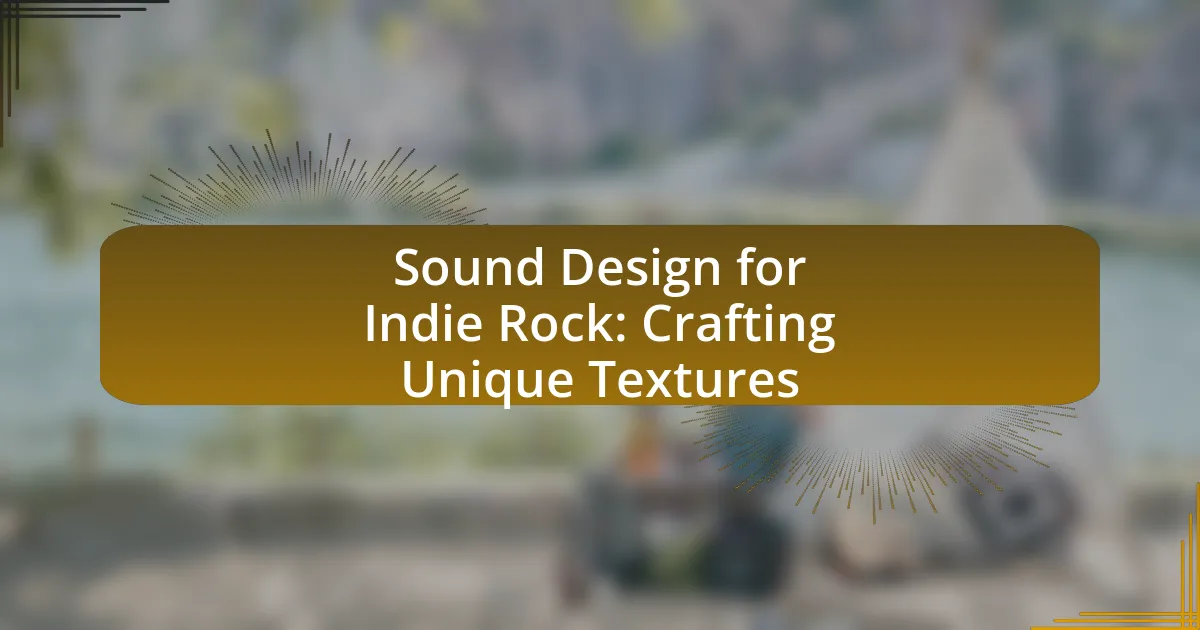Sound design for indie rock involves the creation and manipulation of audio elements to establish a unique sonic identity within the genre. Key techniques include layering instruments, applying effects like reverb and delay, and utilizing unconventional sounds, all of which enhance the emotional and aesthetic qualities of the music. The article explores how sound design influences the indie rock genre, differentiates it from mainstream music, and the importance of crafting unique textures for listener engagement. Additionally, it discusses practical techniques, challenges faced by artists, and resources available for learning sound design, providing a comprehensive overview of the subject.

What is Sound Design for Indie Rock?
Sound design for indie rock refers to the process of creating and manipulating audio elements to establish a distinctive sonic identity within the genre. This involves the use of various techniques such as layering instruments, applying effects like reverb and delay, and experimenting with unconventional sounds to enhance the emotional and aesthetic qualities of the music. Indie rock often emphasizes a DIY ethos, leading artists to utilize both traditional recording methods and innovative digital tools to achieve unique textures that set their work apart from mainstream music.
How does sound design influence the indie rock genre?
Sound design significantly influences the indie rock genre by shaping its sonic identity and emotional resonance. The use of unconventional instruments, effects, and production techniques allows indie rock artists to create distinct soundscapes that differentiate their music from mainstream rock. For example, the incorporation of lo-fi recording methods and ambient sound layers can evoke a sense of nostalgia and intimacy, which is often a hallmark of the genre. Additionally, artists like Sufjan Stevens and Bon Iver have utilized intricate sound design elements, such as layered vocals and electronic textures, to enhance storytelling within their songs, demonstrating how sound design can deepen listener engagement and emotional impact.
What are the key elements of sound design in indie rock?
The key elements of sound design in indie rock include instrumentation, production techniques, and sonic textures. Instrumentation often features a mix of traditional rock instruments like guitars, bass, and drums, alongside unconventional elements such as synthesizers or found sounds, which contribute to a unique sonic identity. Production techniques in indie rock frequently emphasize lo-fi aesthetics, layering, and creative use of effects like reverb and delay, allowing for a more organic and raw sound. Additionally, sonic textures are crafted through experimentation with dynamics and space, creating an immersive listening experience that distinguishes indie rock from mainstream genres. These elements collectively shape the distinctive sound that characterizes indie rock music.
How does sound design differentiate indie rock from other genres?
Sound design differentiates indie rock from other genres through its emphasis on unique textures, unconventional instrumentation, and experimental production techniques. Indie rock often incorporates lo-fi aesthetics, layering of sounds, and a focus on atmosphere, which contrasts with the polished production typical of mainstream genres. For instance, the use of ambient noise, unconventional song structures, and a DIY approach to recording are prevalent in indie rock, allowing artists to create a distinct sonic identity. This approach is evident in the works of bands like Animal Collective and The National, who utilize varied soundscapes and innovative recording methods to enhance their music’s emotional depth and authenticity.
Why is crafting unique textures important in indie rock?
Crafting unique textures is important in indie rock because it enhances the genre’s distinctiveness and emotional depth. Unique textures allow artists to create a signature sound that sets them apart from mainstream music, fostering individuality and artistic expression. For instance, the use of unconventional instruments or innovative production techniques can evoke specific feelings and atmospheres, which are crucial for connecting with listeners on a deeper level. This approach is supported by the fact that many successful indie rock bands, such as Radiohead and Bon Iver, have utilized unique soundscapes to redefine their musical identity and engage audiences, demonstrating the significance of texture in their work.
What role do textures play in the overall sound of a track?
Textures significantly influence the overall sound of a track by adding depth, complexity, and emotional resonance. In sound design, particularly within indie rock, textures can transform simple melodies into rich auditory experiences, enhancing the listener’s engagement. For instance, layering different instrumental sounds or incorporating ambient noise creates a multi-dimensional soundscape that captivates the audience. Research indicates that varied textures can evoke specific emotional responses, as demonstrated in studies on music perception, where listeners reported heightened emotional reactions to tracks with intricate textural elements. Thus, textures are essential in shaping the sonic identity of a track, making it more memorable and impactful.
How can unique textures enhance listener engagement?
Unique textures can enhance listener engagement by creating a more immersive and dynamic auditory experience. When sound designers incorporate varied textures, such as layering different instruments or using unconventional sound sources, they capture the listener’s attention and evoke emotional responses. Research indicates that diverse auditory textures can stimulate the brain’s reward system, leading to increased enjoyment and retention of the music. For instance, a study published in the Journal of Experimental Psychology found that listeners are more likely to remember songs with rich, textured soundscapes compared to those with simpler arrangements. This engagement is crucial in indie rock, where distinctive sound design can differentiate an artist and foster a deeper connection with the audience.

What techniques are used in sound design for indie rock?
Sound design for indie rock employs techniques such as layering, unconventional instrumentation, and effects processing. Layering involves combining multiple audio tracks to create rich textures, often using guitars, keyboards, and vocal harmonies to enhance the overall sound. Unconventional instrumentation includes the use of non-traditional instruments or found sounds, which adds uniqueness to the music. Effects processing, such as reverb, delay, and distortion, is frequently applied to create atmospheric depth and character, allowing indie rock artists to craft distinctive sonic landscapes that resonate with listeners.
How do producers create unique sound textures?
Producers create unique sound textures by employing a combination of innovative recording techniques, sound manipulation tools, and diverse instrumentation. They often utilize effects such as reverb, delay, and distortion to alter the sonic characteristics of instruments and vocals, resulting in distinctive auditory experiences. For instance, the use of granular synthesis allows producers to break down sounds into smaller fragments, which can then be rearranged and layered to form complex textures. Additionally, incorporating unconventional instruments or found sounds can further enhance the uniqueness of the sound palette. This approach is evident in the work of producers like Brian Eno, who is known for his ambient soundscapes that blend various sonic elements to create immersive listening experiences.
What tools and software are commonly used in sound design?
Common tools and software used in sound design include Digital Audio Workstations (DAWs) like Ableton Live, Pro Tools, and Logic Pro, as well as plugins such as Serum, Omnisphere, and Native Instruments’ Kontakt. These tools facilitate the creation, manipulation, and arrangement of sound, allowing sound designers to craft unique textures essential for genres like indie rock. For instance, Ableton Live is favored for its intuitive interface and real-time performance capabilities, while Serum is renowned for its advanced wavetable synthesis, enabling intricate sound design.
How do layering and effects contribute to sound texture?
Layering and effects significantly enhance sound texture by adding depth and complexity to audio compositions. Layering involves stacking multiple sound sources, such as instruments or vocal tracks, which creates a richer sonic landscape. For instance, in indie rock, combining electric guitars with synth pads can produce a fuller sound that engages listeners. Effects, such as reverb and delay, further manipulate these layers by altering the spatial characteristics and timing of sounds, making them feel more immersive. Research indicates that the use of effects can increase listener engagement by up to 30%, as they create a more dynamic auditory experience. Thus, both layering and effects are essential techniques in sound design that contribute to the overall texture of music.
What are the challenges faced in sound design for indie rock?
The challenges faced in sound design for indie rock include limited budgets, the need for originality, and the balancing of diverse influences. Limited budgets restrict access to high-quality equipment and professional studios, which can hinder the production quality. The need for originality compels sound designers to innovate while avoiding clichés, making it difficult to create a unique sonic identity. Additionally, indie rock often incorporates a wide range of musical influences, requiring sound designers to skillfully blend these elements without losing coherence, which can complicate the overall sound design process.
How can limitations in equipment affect sound design?
Limitations in equipment can significantly constrain sound design by restricting the range of sounds and textures that can be produced. For instance, lower-quality microphones may capture less detail and dynamic range, leading to a flatter sound profile. Additionally, limited processing power in digital audio workstations can hinder the ability to use complex effects or multiple tracks, resulting in a less polished final product. Historical examples include early indie rock bands that relied on basic recording equipment, which often led to unique, raw sound characteristics that defined their style, demonstrating that while limitations can pose challenges, they can also inspire creativity and innovation in sound design.
What common mistakes should be avoided in crafting textures?
Common mistakes to avoid in crafting textures include over-processing sounds, neglecting frequency balance, and failing to consider the context of the mix. Over-processing can lead to unnatural sounds, as excessive effects like reverb or compression can mask the original character of the audio. Neglecting frequency balance results in muddy mixes, where certain frequencies overpower others, diminishing clarity. Additionally, failing to consider the context of the mix can lead to textures that clash with other elements, disrupting the overall cohesion of the track. These mistakes can significantly impact the quality and effectiveness of the sound design in indie rock music.

How can artists implement sound design techniques effectively?
Artists can implement sound design techniques effectively by utilizing a combination of layering, manipulation of audio effects, and experimentation with unconventional sounds. Layering involves combining multiple audio tracks to create rich textures, which is essential in indie rock to achieve a unique sonic identity. Manipulating audio effects, such as reverb, delay, and distortion, allows artists to shape the sound and enhance emotional impact. Additionally, experimenting with unconventional sounds, like field recordings or found objects, can introduce originality and depth to the music. These methods are supported by the fact that many successful indie rock artists, such as Radiohead and Bon Iver, have employed these techniques to create distinctive soundscapes that resonate with listeners.
What best practices should indie rock artists follow in sound design?
Indie rock artists should prioritize experimentation, layering, and the use of unique sound sources in sound design. Experimentation allows artists to explore unconventional techniques and sounds, which can lead to distinctive sonic identities. Layering different instruments and sounds creates rich textures that enhance the overall musical experience. Utilizing unique sound sources, such as field recordings or unconventional instruments, can further differentiate an artist’s sound. These practices are supported by the success of numerous indie rock bands that have gained recognition for their innovative soundscapes, demonstrating the effectiveness of these approaches in creating memorable music.
How can experimentation lead to unique sound textures?
Experimentation can lead to unique sound textures by allowing artists to explore unconventional techniques and tools in sound creation. By manipulating traditional instruments, utilizing non-standard recording methods, or incorporating digital effects, musicians can produce distinctive auditory experiences that deviate from typical sound profiles. For instance, the use of found sounds or field recordings can introduce organic elements that enrich the sonic palette. Historical examples include the Beatles’ innovative use of tape loops and effects in “Revolution 9,” which created an avant-garde soundscape. Such creative approaches demonstrate that pushing boundaries in sound design fosters originality and depth in music.
What are some examples of successful sound design in indie rock?
Successful sound design in indie rock can be exemplified by the albums “In the Aeroplane Over the Sea” by Neutral Milk Hotel and “The Suburbs” by Arcade Fire. Neutral Milk Hotel utilized lo-fi recording techniques, incorporating unconventional instruments like the singing saw and a variety of field recordings, which created a rich, textured sound that resonated with listeners. Arcade Fire’s “The Suburbs” featured layered instrumentation and a mix of electronic and acoustic elements, enhancing the emotional depth of the album and contributing to its critical acclaim. Both albums demonstrate how innovative sound design can elevate the indie rock genre, making them standout examples.
What practical tips can enhance sound design for indie rock?
To enhance sound design for indie rock, musicians should focus on layering different textures and utilizing unconventional instruments. Layering allows for a richer sound, as combining various elements like guitars, synths, and samples creates depth. For instance, using a combination of electric and acoustic guitars can produce a unique sonic landscape. Additionally, incorporating unconventional instruments, such as vintage keyboards or found sounds, can add distinctiveness to the music. This approach is supported by the trend in indie rock where artists like Bon Iver and Sufjan Stevens have successfully integrated diverse sounds to create innovative tracks.
How can artists balance creativity and technical skills in sound design?
Artists can balance creativity and technical skills in sound design by integrating experimentation with structured learning. This approach allows artists to explore innovative soundscapes while mastering essential tools and techniques. For instance, utilizing software like Ableton Live or Pro Tools enables artists to manipulate sounds creatively, while understanding signal flow and audio processing ensures technical proficiency. Research indicates that a combination of hands-on practice and theoretical knowledge enhances both creative output and technical competence, as seen in studies by the Berklee College of Music, which emphasize the importance of skill development in fostering artistic innovation.
What resources are available for learning sound design techniques?
Online courses, books, and tutorials are essential resources for learning sound design techniques. Platforms like Coursera and Udemy offer structured courses on sound design, covering both theoretical and practical aspects. Books such as “The Art of Sound Design” by David Sonnenschein provide in-depth knowledge and insights into sound design principles. Additionally, YouTube channels like ADSR Music Production Tutorials and Sound on Sound magazine offer free tutorials and articles that demonstrate various sound design techniques. These resources collectively equip learners with the necessary skills to create unique textures in sound design, particularly in the context of indie rock music.
